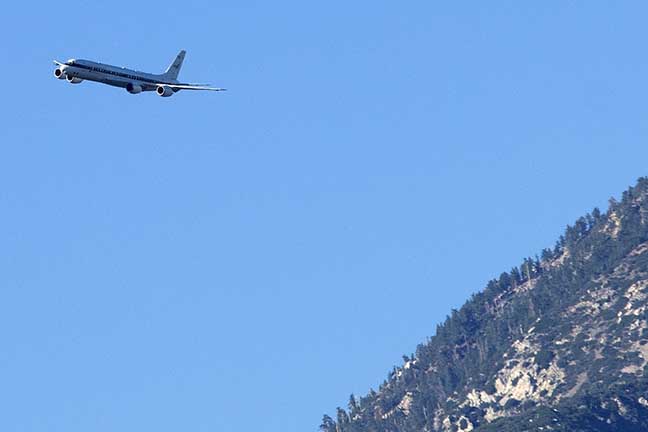NASA ‘flying laboratory’ seen cruising over Claremont

A NASA DC-8 makes a low pass over Claremont Saturday as part of a four day experiment to measure air quality in Southern California. Courier photo/Steven Felschundneff
by Steven Felschundneff | steven@claremont-courier.com
Claremont residents looking skyward last week may have been startled to see what appeared to be a passenger jet flying at a low altitude directly over our city.
However, there was no need for alarm, it was simply the U.S. government conducting air quality research.
The project, called Atmospheric Emissions and Reactions Observed from Megacities to Marine Areas or AEROMMA, flew four missions over Southern California between Tuesday, August 22 and Saturday, August 26. The scientists conducted similar experiments in our area in June.
“NASA Armstrong Flight Research Center’s DC-8 aircraft will fly over the Los Angeles urban area as part of a collaborative scientific research mission with [National Oceanic and Atmospheric Administration] called AEROMMA,” according to a news release from Erica Heim, a public affairs officer at NASA.
The DC-8 aircraft made multiple passes per flight over Claremont during the four-day experiment, but largely kept to the northern part of town near the mountains.

A NASA DC-8 makes a low pass over Claremont Saturday as part of a four day experiment to measure air quality in Southern California. Courier photo/Steven Felschundneff
“All flyovers are conducted at a safe altitude without harm to public, wildlife, or infrastructure. Jet aircraft are very loud and those with sensitivity to loud noises should be aware of the flyover window,” according to the news release.
According to Heim, the jet aircraft is “the largest flying science laboratory in the world,” and the project “brings together airborne, ground, and satellite observing systems, and state-of-the-art air quality and climate models to gather data on air quality.”
The study began in mid-June and is scheduled to run through the end of this month. The goal is to collect samples of air hovering over the most densely populated areas in North America including Los Angeles, Chicago, New York, and Toronto.
“The DC-8 will conduct a series of low-altitude flights in order to investigate urban emissions and the atmospheric chemical reactions that affect air quality and climate,” According to a news release from Heim.
Most air quality studies look at pollution centered around transportation, but the main goal of this project is to evaluate air pollution that comes from everyday items that people use such as personal care products, cleaning agents, and small gas burning devices. It will also measure emissions from landfills.
“These volatile ingredients are often refined from fossil fuels and affect our shared air quality. In major cities, that effect is tangible and measurable,” according to Heim.








0 Comments